10 simple core workouts on your mini-rebounder include basic knee lifts, air bikes, jump tucks, planks, and V-ups to effectively strengthen your abdominals. Try twisting jumps for obliques, seated bounces for lower abs, and one-leg balance exercises for deep core muscles. Add ankle weights to increase resistance or use the handlebar for stability when needed. These low-impact exercises protect your joints while delivering impressive core-strengthening benefits you’ll soon discover.
10 Simple Core Workouts On Your Mini-Rebounder
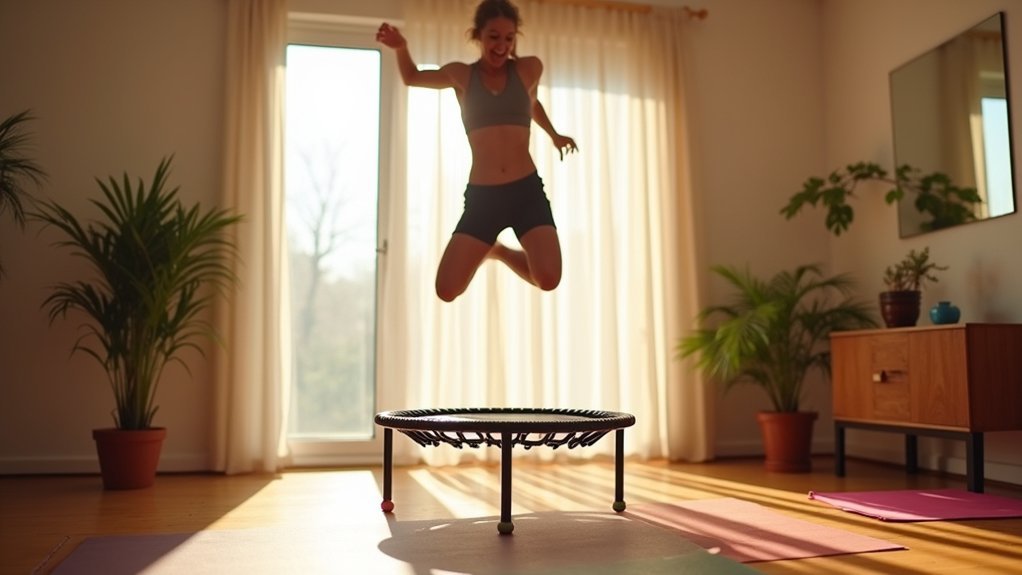
Five simple exercises can transform your mini-rebounder into a powerhouse for core development. Your fitness trampoline offers the perfect surface for air bikes and jump and tucks, which engage your rectus abdominis and obliques while boosting your heart rate simultaneously.
Unleash your core’s potential through mini-rebounder exercises that simultaneously strengthen abs, obliques, and elevate cardiovascular fitness.
Try performing planks and crunches on the unstable surface to challenge your core stability. The dynamic movement of the trampoline intensifies these traditional exercises, forcing your diaphragm and abdominal muscles to work harder.
For maximum results, add ankle weights to increase resistance during your core workouts. A structured 10-minute routine combining jumping and targeted core exercises delivers time-efficient training.
The low-impact nature of mini-rebounder exercises protects your joints while still delivering powerful core engagement benefits.
Basic Knee Lifts for Core Activation
Begin your core training journey with knee lifts, the foundation of effective mini-rebounder workouts. Stand with feet shoulder-width apart, engaging your core as you lift each knee toward your chest. This simple movement requires balance and stabilization, activating multiple core muscles simultaneously.
To maximize your fitness results:
- Maintain a steady rhythm to elevate your heart rate while toning your core
- Add arm movements to increase intensity and engage more core muscles
- Keep proper alignment by looking straight ahead and maintaining good posture
- Challenge yourself by extending legs during lifts or adding ankle weights for resistance
These knee lifts not only strengthen your core but also improve your balance and coordination—making them perfect for building a solid foundation for more advanced rebounding exercises.
Air Bike Variations for Oblique Strength
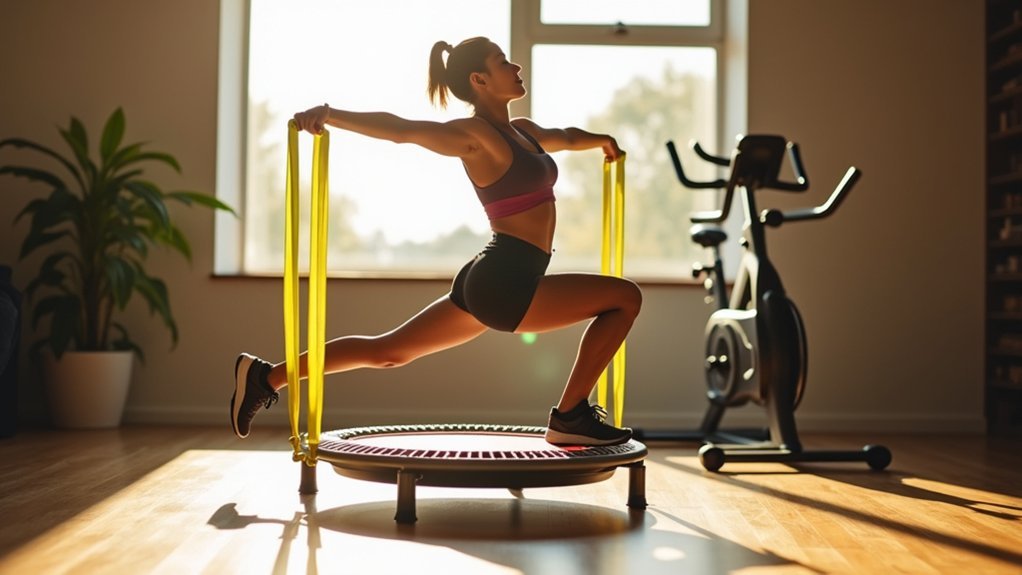
After mastering knee lifts, you’ll want to target those side abdominal muscles with Air Bike variations on your mini-rebounder. Lying on your back, rotate your torso while bringing opposite knees and elbows together in a cycling motion to effectively engage your obliques.
| Variation | Benefit | Difficulty |
|---|---|---|
| Slow Air Bike | Builds core strength | Beginner |
| Speed Air Bike | Increases intensity | Intermediate |
| Extended Leg Bike | Enhances stability | Advanced |
| Weighted Air Bike | Maximizes resistance | Advanced |
| Alternating Hold | Improves endurance | Intermediate |
Start with slower rotations as a beginner, then gradually increase speed as you develop better coordination. Just 10 minutes of Air Bike exercises can greatly improve your oblique definition and core stability, making everyday movements easier and more efficient.
Jump and Tuck Movements for Abdominal Toning
You’ll achieve maximum core activation during Jump and Tuck exercises by starting in a ¾ squat position and forcefully drawing your knees toward your chest while airborne.
For proper form, maintain a tight core throughout the movement and use the rebounder’s handlebar if you’re struggling with balance or just beginning.
Once you’ve mastered the basic technique, try advanced variations like single-leg tucks or oblique-focused twisting tucks to further challenge your abdominal muscles.
Proper Form Fundamentals
Mastering the Jump and Tuck exercise requires five key elements of proper form to effectively target your abdominal muscles.
Begin by standing with your feet shoulder-width apart on the mini-rebounder, creating a stable foundation. Before jumping, lower into a ¾ squat position—this vital step engages your core and prepares your muscles for maximum activation.
As you propel upward, focus on:
- Pulling your knees toward your chest while maintaining a straight back
- Using the handlebar for stability, especially as a beginner
- Keeping your core engaged throughout the entire movement
- Gradually increasing jump height as your abdominal strength improves
With consistent practice, you’ll develop proper form that maximizes core activation and delivers results.
Start with fewer repetitions and build up as your technique improves.
Advanced Tuck Variations
Once you’ve mastered basic form, it’s time to challenge your abdominals with advanced tuck variations on your mini-rebounder.
The “jump and tuck” exercise powerfully works your core by combining a low squat with an explosive jump that brings your knees toward your chest.
This movement not only targets abdominal muscles but also elevates your heart rate, delivering cardiovascular benefits alongside strength training.
Use the handlebar for support to achieve higher jumps and maintain proper form.
Begin at a comfortable pace and gradually increase speed and height as your strength develops.
For an extra challenge, try adding ankle weights to intensify the workout.
These advanced tuck variations create greater core engagement and more effective abdominal toning than standard bouncing movements, transforming your mini-rebounder into a complete core-strengthening station.
Trampoline Planks for Full Core Stability
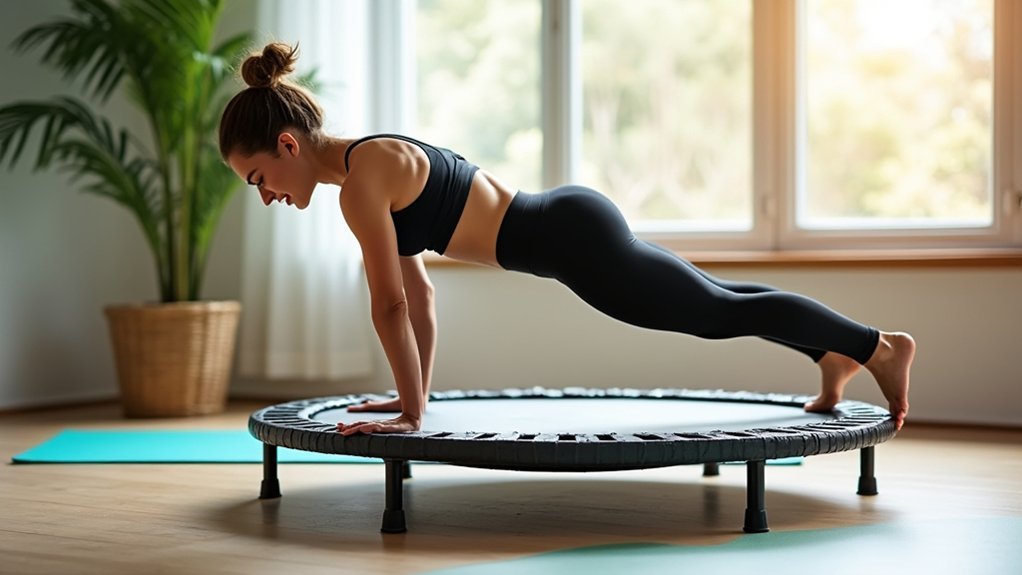
While traditional planks already challenge your core, elevating this exercise on a mini-rebounder greatly amplifies its effectiveness.
Trampoline planks engage multiple muscle groups simultaneously, including your rectus abdominis, obliques, and pelvic floor, enhancing overall core stability.
Position yourself with either your elbows or feet on the trampoline, maintaining a straight back throughout the movement.
Begin by holding for 10-15 seconds, then gradually progress to one-minute holds as your strength improves.
- Watch video tutorials to guarantee proper form and technique
- Start with shorter durations and build up gradually
- Focus on keeping your back straight and core engaged
- Incorporate into your routine 2-3 times weekly for best results
You’ll notice improved balance and posture as your core stability develops, benefiting your performance in everyday activities.
Rebounding Crunches With Proper Form
Rebounding crunches offer a natural progression from plank exercises, allowing you to target your abdominal muscles with dynamic movement.
Begin by lying flat on your mini-rebounder with knees bent and feet positioned hip-width apart for stability.
As you perform rebounding crunches, engage your core while lifting your upper body toward your knees. Keep your head and neck relaxed to avoid strain.
Hold each crunch momentarily before returning to the starting position with controlled movements.
For best results, complete 10-15 repetitions while maintaining proper form throughout.
If you’re looking to increase intensity, try adding ankle weights for additional resistance and stronger core engagement.
This simple modification transforms basic rebounding crunches into a more challenging workout that effectively builds abdominal strength.
V-Ups and Scissor Legs on Your Rebounder
Two powerful exercises that target your deep core muscles are V-ups and scissor legs, both perfectly adapted for the mini-rebounder. When performing V-ups, lift your arms and legs simultaneously to create a “V” shape with your body, fully engaging your abdominals.
If you’re new to this movement, start with basic leg raises before advancing to complete V-ups.
- Add ankle weights to both V-ups and scissor legs for increased resistance
- Perform scissor legs by lying on your back and alternating leg lifts in a crossing motion
- Begin with 10-12 repetitions of each exercise, gradually increasing as you build strength
- Focus on controlled movements rather than speed to maximize core engagement
These exercises will greatly improve your core stability and overall rebounding performance.
Twisting Jumps for Rotational Core Power
Twisting jumps on your mini-rebounder challenge your obliques through the proper torso twist technique—start with small rotations before increasing your range of motion.
You’ll notice immediate oblique engagement benefits as these muscles work to control your body’s rotation while maintaining balance on the unstable surface.
Begin with basic twists at a comfortable height before progressing to more advanced difficulty levels with higher jumps and greater rotational angles.
Torso Twist Technique
The Torso Twist Technique represents one of the most effective rotational exercises you can perform on a mini-rebounder. This dynamic movement engages your oblique core muscles while simultaneously providing cardiovascular benefits.
Start with your feet shoulder-width apart, lower into a slight squat, then jump and twist your torso, bringing your knees side to side.
For maximum effectiveness:
- Perform 10-15 twists per set to properly engage core muscles and elevate heart rate
- Keep your landings soft to protect joints while maintaining control
- Add ankle weights to increase intensity and challenge your core further
- Focus on controlled rotation rather than height to target obliques effectively
This technique doesn’t just strengthen your core—it improves balance and coordination through the combined jumping and twisting motions.
Oblique Engagement Benefits
While traditional core workouts often focus on forward and backward movements, rotational exercises like twisting jumps on a mini-rebounder target your obliques with unparalleled effectiveness. When you perform these moves on ACON FIT rebounders, you’ll develop essential rotational strength needed for sports and daily activities.
| Benefit | How It Works | Result |
|---|---|---|
| Enhanced Balance | Activates obliques during dynamic movement | Improved stability and posture |
| Muscle Definition | Targets side abdominals consistently | More toned midsection aesthetics |
| Cardiovascular Boost | Combines aerobic activity with strength | Efficient full-body conditioning |
| Coordination | Synchronizes upper and lower body movements | Better agility and athletic performance |
You’ll notice improved oblique engagement translates directly to better posture and reduced risk of injury, making twisting jumps an essential addition to your rebounding routine.
Progressive Difficulty Levels
Moving from oblique engagement to practical implementation, you’ll find that twisting jumps on a mini-rebounder offer multiple intensity levels to match your fitness journey.
Start with basic twisting jumps keeping your feet together while maintaining a strong core to protect your lower back during rotation.
As your core activation improves, progress through these difficulty levels:
- Begin with 10-15 repetitions of basic twisting jumps with feet together
- Advance to alternating legs during twisting jumps for increased challenge
- Add ankle weights to intensify resistance and promote greater core strength
- Incorporate faster rotations while maintaining proper form for enhanced rotational power
This progression not only targets your obliques effectively but simultaneously improves your cardiovascular endurance, making twisting jumps a time-efficient addition to your rebounder routine.
Seated Bounces for Lower Abdominal Focus
Targeting your lower abdominals becomes surprisingly effective when you’re seated on a mini-rebounder. Simply sit on the rebounder with feet flat on the mat, lean back slightly, and engage your core to initiate gentle bouncing movements. This position specifically activates those hard-to-reach lower abdominal muscles while improving pelvic stability.
For greater intensity, try extending your legs during the bounce to challenge your core control further. These seated bounces offer an accessible yet powerful option for all fitness levels.
| Experience Level | Benefits | Intensity | Form Tips |
|---|---|---|---|
| Beginner | Core activation | Low | Keep back straight |
| Intermediate | Improved coordination | Medium | Extend arms forward |
| Advanced | Enhanced stability | High | Single leg extension |
| All Levels | Low-impact strengthening | Adjustable | Focus on controlled movement |
Standing Balance Exercises for Deep Core Muscles
Standing on your mini-rebounder with one leg creates an instant challenge for your deep core muscles, forcing them to stabilize your entire body.
Try holding your single-leg stance for 30 seconds before switching sides, then progress to adding arm movements or closing your eyes for increased difficulty.
For an advanced balance challenge, perform small controlled bounces while maintaining your one-leg position, which will recruit even more core fibers and greatly improve your proprioception.
One-Leg Stance Variations
While many core workouts focus on floor exercises, one-leg stance variations on a mini-rebounder offer exceptional benefits for your deep core muscles.
When you balance on one leg on the unstable rebounder surface, your pelvic floor and transverse abdominis activate immediately, building core stability that translates to better posture and athletic performance.
- Try lifting one knee while extending your arms overhead to challenge your balance and engage deeper core muscles.
- Add gentle bounces while maintaining the one-leg stance to increase the intensity.
- Incorporate arm circles or reaches while balancing to further activate your core stabilizers.
- Alternate between legs for 30-second holds to develop balanced strength.
You’ll notice improved proprioception and stability in your daily activities as your body learns to maintain balance during these dynamic, challenging positions.
Rebounding Balance Challenges
To elevate your core strength beyond basic routines, balance challenges on a mini-rebounder create an ideal environment for deep muscle activation. Your body constantly adjusts to the unstable surface, engaging stabilizer muscles that ordinary workouts miss.
Try performing knee lifts while maintaining your balance, forcing your core to work overtime. Add lateral leg raises to target your obliques and pelvic floor—crucial components of a strong foundation.
For an extra challenge, incorporate arm reaches or side kicks while balancing on one leg. These dynamic movements not only increase your heart rate but simultaneously tone your core muscles.
With consistent practice, you’ll notice improved proprioception, better balance, and enhanced functional fitness. Your daily activities will become easier as your body awareness grows, making these standing exercises valuable beyond just core strength.
Frequently Asked Questions
Does Rebounding Work Your Core?
Yes, rebounding works your core effectively. You’ll engage your abdominal muscles while maintaining balance on the trampoline. Your body constantly stabilizes during jumps, which strengthens your core muscles with each bounce.
How Do You Tone Your Stomach With a Rebounder?
To tone your stomach with a rebounder, you’ll want to do core-focused exercises like crunches, V-ups, planks, and jump-tucks. Adding ankle weights increases resistance, while consistent 10-minute workouts maximize results through combined jumping and ab exercises.
What Is 10 Minutes on a Rebounder Equivalent To?
Ten minutes on a rebounder equals about 30 minutes of jogging. You’ll burn 50-100 calories while improving balance, boosting lymphatic circulation, and engaging your core muscles 30% more than floor exercises would.
Can You Lose Belly Fat on a Mini Trampoline?
Yes, you can lose belly fat on a mini trampoline. It’s an effective cardio workout that burns calories, especially when you’re doing high-intensity exercises. Combine it with a healthy diet for best results.
In Summary
Your mini-rebounder isn’t just for cardio—it’s a powerful core-strengthening tool. By incorporating these ten simple exercises into your routine, you’ll engage your entire core while enjoying low-impact, joint-friendly workouts. You don’t need fancy equipment or hours at the gym to build a stronger core. Just hop on your rebounder 2-3 times weekly, and you’ll soon notice improved stability, better posture, and a more defined midsection.

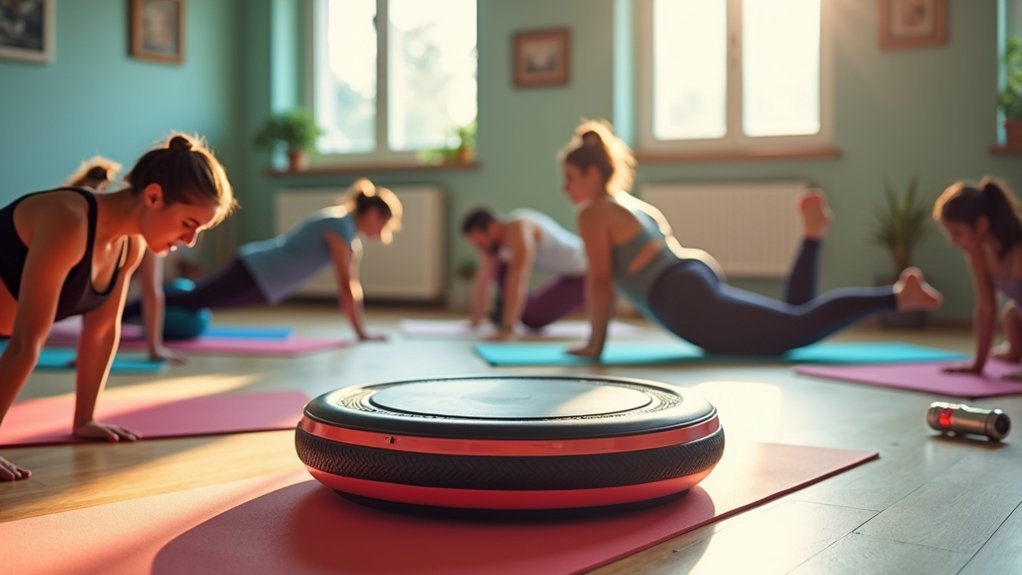

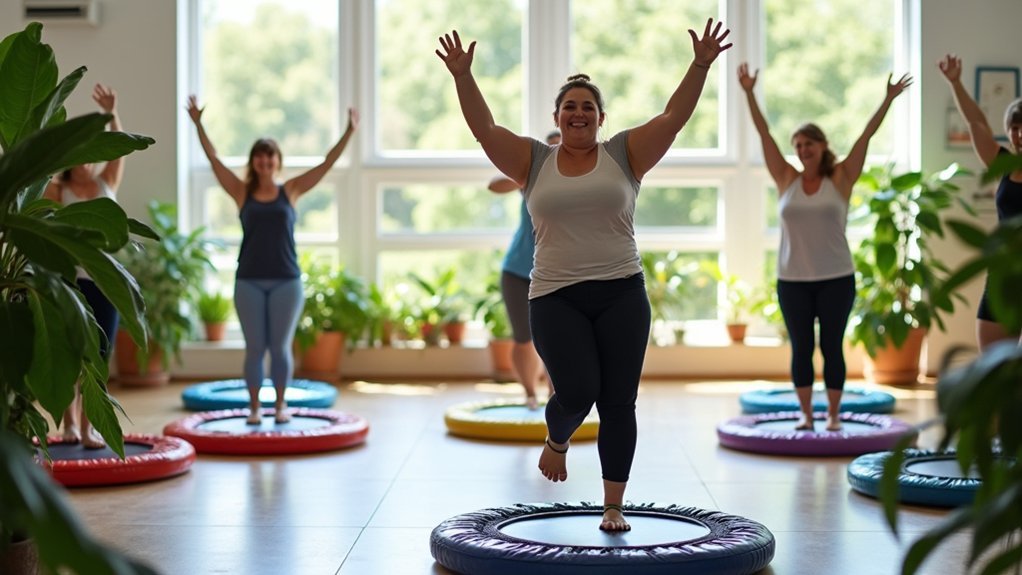
Leave a Reply